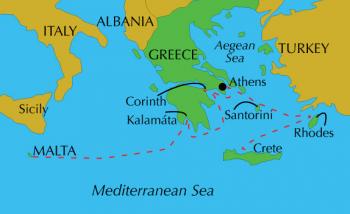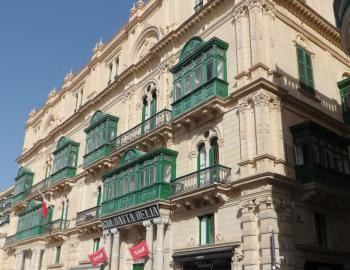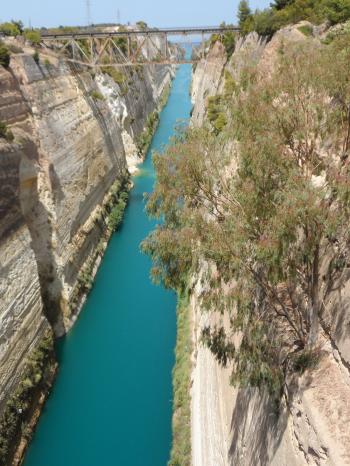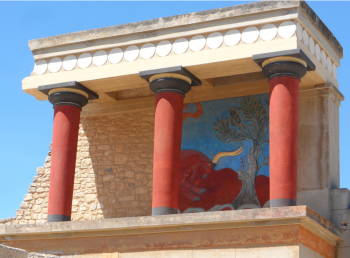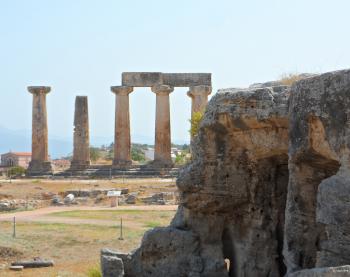Back on board – feeling secure on a COVID-era cruise to Malta and Greece
This article appears on page 6 of the November 2021 issue.
My husband, Phil, and I are proud 30-plus-year ITN subscribers and ITN Quarto Mondo award recipients, having now been to well over one quarter of the world’s nations. While traveling, our primary interests are ancient cultures, architecture, art and religions, and we used to plan all our own trips, including arranging our own transportation.
Due to our advancing age, however, we’ve become fans of cruising as a means of accessing destinations of special interest to us. We’ve now been on four Viking ocean cruises and two river cruises, and they’ve been great.
But, like most, if not all, ITN readers, we’ve been “travel deprived” lately by Covid regulations and restrictions, so when we learned that Viking (855/338-4546, vikingcruises.com) was offering a cruise that included the “birthplace of democracy,” we jumped at it.
Offering new and exceptional opportunities for us to learn about the prehistoric, Neolithic and Bronze Age periods that we’ve long been interested in, the 11-day “Malta & Greek Isles Discovery” cruise on the Viking Sea, July 31-Aug. 10, 2021, would depart from Valletta, Malta, and include stops in Kalamáta, Athens, Santorini, Rhodes and Crete. The itinerary featured visits to a number of rich archaeological and historic sites — a cruise that was made for us!
As it unfolded, we were amazed by what we saw and learned. Overall, this experience was the best we have enjoyed with Viking and one of the best of all of our travels.
A few rules
Travel during this time did require us to navigate numerous and confusing Covid regulations and restrictions, complicating our planning for the trip. A great deal of research and effort were necessary to get the appropriate travel and health documentation needed by the various authorities. Nevertheless, when under way, the actual trip went relatively smoothly.
The cruise itself was restricted to only travelers who were fully vaccinated — a requirement for the crew as well — and the ship operated at about half capacity (approximately 450 passengers), as Viking very gradually, systematically and responsibly geared up to full operating level.
Viking’s onboard Covid protection protocol included, but was not limited to, daily PCR and temperature checks; contact-tracking sensors and face masks to be worn in all public places; distanced dining tables; multiple hand-washing and hand-sanitizer stations; no self-serve buffets, and rooms cleaned twice daily. Verified vaccination records and Covid test results were required before boarding.
We quickly adjusted to these requirements and were impressed with how dedicated the Viking staff was in making the cruise so safe and pleasant.
Once under way, it was very apparent that tourism, the lifeblood of the areas we visited, was hugely affected by the pandemic. Sites were not crowded, and, in fact, the Viking Sea was the only cruise ship in many of our ports of call.
Malta
Malta had been on our bucket list for a long time, and it did not disappoint. The harbor of Valletta was scenic and impressive — dominated by massive walls and ancient buildings. Our ship docked immediately beside the outer walls that fortify the port, offering a dramatic first impression.
The “new” capital of Valletta was established in 1566, and its 16th-century Baroque palaces and buildings were constructed by the Knights of St. John (Hospitallers). Standing in visual contrast, many severe-looking buildings dating to the Mussolini/Fascist era still remain within the city walls.
Massively damaged in WWII, much of the Old Town and its surrounding walls have been reconstructed, but done in a way much in keeping with the original character and “feeling” of the place.
Mdina, the walled “old” capital, was our next stop. Founded around the 8th century BC, the place is extraordinary and feels almost like a time capsule.
The whole city seemed untouched, spotless (no litter or graffiti) and virtually uninhabited. We then learned that Mdina is now known locally as the “silent city.” since its population is only about 300.
Some of its excellent buildings — largely medieval in character, with Baroque features — were adorned with enclosed wooden balconies of distinctive Moorish design.
We walked down narrow, curving walkways that were angled to deflect arrows, which, of course, would follow a straight line.
On to Greece
From Kalamáta, connected to mainland Greece by a narrow stretch of land and famed for its eponymous olives, we chose an excursion that took us to the UNESCO World Heritage Site of Mystras, a medieval fortified town located in the Laconia region of the Peloponnese. This Byzantine-era castle-city, constructed by William II of Villehardouin in AD 1249, flourished during the 14th-16th centuries.
The well-preserved complex consists of three parts: the lower section, with a main church and monastery, both with many mosaics intact; the middle, with the Palace of the King, and the upper town, dominated by the castle at the top of the hill.
Fair warning — the trek to the upper town is steep and arduous. Our tour group was only able to make it to the second level, in part due to an exceptional heat wave that caused temperatures to rise as high as 104°F. Nevertheless, a good number of our intrepid fellow passengers split off to visit the timeless Byzantine church with its rich original frescoes still intact.
Next up was a 2-day stop in Athens. We had visited Athens several times before, but new to us was the new Acropolis Museum. This is an excellent and informative addition to the Acropolis site.
The second day of this stop took us to Corinth. Occupied almost continuously from Neolithic to Byzantine times, the site is now only partially intact, having endured numerous earthquakes and sieges. The prominent feature there is the Temple of Apollo, with its seven standing monolithic columns — most unusual, since Greek columns were typically constructed in sections. A side trip to the Corinth Canal was especially interesting.
Rhodes
The Greek island of Rhodes is located only 18 kilometers from Turkey. Its port features massive, heavily fortified walls constructed during the medieval period that surround the Palace of the Grand Master, among the finest examples of medieval military structures in the world. We were greeted with a splendid view of both from our ship upon docking.
Thanks to extensive and respectful restoration, the palace and bastions seemed almost new. Our tour of the palace was well worthwhile, exploring many very large rooms with impressive mosaic floors.
The Street of the Knights connects the harbor with the palace and is lined by the Inns of the Tongues, representing the seven countries of origin of the Knights of St. John. The original, ornate coat of arms of each country decorates the entry doors of its corresponding inn.
The street experience, itself, was extraordinary. Walking down the narrow, cobbled passage was almost like a “time travel” walk taken 700 years before.
We had an outstanding guide while on Rhodes, Portokalenia Vratsali (email [email protected]), who had 25-plus years’ experience in the Ministry of Culture (Department of Local Antiquity) and who actually spent part of her childhood living in the palace with her parents, both of whom were also archaeologists.
More island visits
Santorini is probably the most visited of the Greek islands, but it held the least interest for us. The main attraction of its modern city of Oia seemed to consist primarily of picturesque white buildings, high-end shops and cafés. It was also very crowded, though apparently much less so than during typical summers prior to Covid.
Nonetheless, the day was redeemed with a visit to the extraordinary archaeological site of Akrotiri, one of the most important prehistoric settlements in the Aegean. Inhabited by Bronze Age Minoans dating back to around 5000 BC, it flourished until it was buried by ash from a volcanic eruption, similar to Herculaneum and Pompeii.
The continuing excavation has revealed Minoan frescoes and a number of multistory buildings that were truly impressive due to the sophistication of the engineering effort that was involved in their creation.
Our guide had brought copies of drawings and photos with her to supplement our tour, and they were highly informative, especially the ones showing the extraordinarily sophisticated art of the period that was now not present on site.
Crete — Knossos, in particular — was the last and, by far, most impactful site we visited. It encapsulated everything we seek to experience in our travels.
Described as the “cradle of Western civilization,” Knossos is the largest Bronze Age archaeological site and the second-most-visited site in all of Greece. (The Acropolis is number one.) A preliminary excavation begun in 1878 by Minos Kalokairinos, an antiquarian from Heraklion, was followed by a more extensive excavation conducted by a British archaeologist in the early 1900s. While more a reconstruction than an authentic restoration, work by the British School at Athens has continued intermittently ever since.
At the center of the refined Minoan city, the Palace of Knossos was the largest of four main “palaces” built on Crete around 1900 BC, three of which were completely destroyed by an earthquake in around 1700 BC. It was the center of the powerful and mysterious Minoan civilization that flourished between 2600 and 1100 BC, and it served multiple purposes, i.e., religious, military, administrative and commercial.
Water supply and underground sewage systems were evidence of high-level engineering expertise, considerably predating those built by the Romans. The architectural complexity of its multistory buildings and the engineering sophistication required were simply amazing and hard to imagine possible at such an early time.
Another surprise was the aesthetic beauty of the interior art and decoration. The walls of the most important rooms were covered with plaster and decorated with delicate and expressive paintings of people and mythological creatures (though, remember, most of the on-site frescoes are replicas, the originals having been moved to museums).
The Throne Room featured painted walls depicting mythical monsters, sacred places and attendants and guardians of deities. A stone “throne” (its actual use is under contention) and a porphyry basin, possibly for holy water, sit in the center of the room.
Also discovered but not on view were the so-called Linear A and Linear B scripts, ancient writing systems used by the Minoans that predate the Greek alphabet by several centuries.
The Palace of Knossos is truly one of the most complex and rich sites we have ever visited, combining everything we are interested in — history, culture, archaeology and art — and it was a splendid, rewarding way to conclude our tour. Our visit there was greatly enhanced by another outstanding and professional guide, Souki Sevastianna (email [email protected]).
Final thoughts
As mentioned at the beginning of this article, the most difficult part of this overall experience was the pre-trip preparation, securing the appropriate tests within a 72-hour window of arrival at our destination and identifying and completing the various entry requirements for Malta, transit countries and airlines (e.g., passenger locator forms, health certifications, etc.).
At times, this was utterly confounding and frustrating, but Viking was very helpful and proactive in identifying these requirements and providing online links.
The cruise price totaled $16,050 for the two of us, a 3.3% reduction from the original price because we paid via electronic check. We had upgraded to an Explorer Suite (which we had never done before) as a very special treat due to our “Travel Deprivation Syndrome.”
The 11-day fare included all meals, with drinks, and one site excursion per day. Early boarding access and priority booking for spa services and excursions, as well as reservations at the specialty restaurants on board (no additional charges required), were added benefits. There were no charges for the daily PCR testing and the negative COVID certification required to reenter the US.
Kudos to the Viking Sea and its staff! It deservedly earns an A+ for this cruise’s educational content, for protecting our health and safety, and for troubleshooting covid obstacles — all while providing great overall comfort and enjoyment on board. For this, we are deeply grateful. This was, indeed, a very bon voyage!


